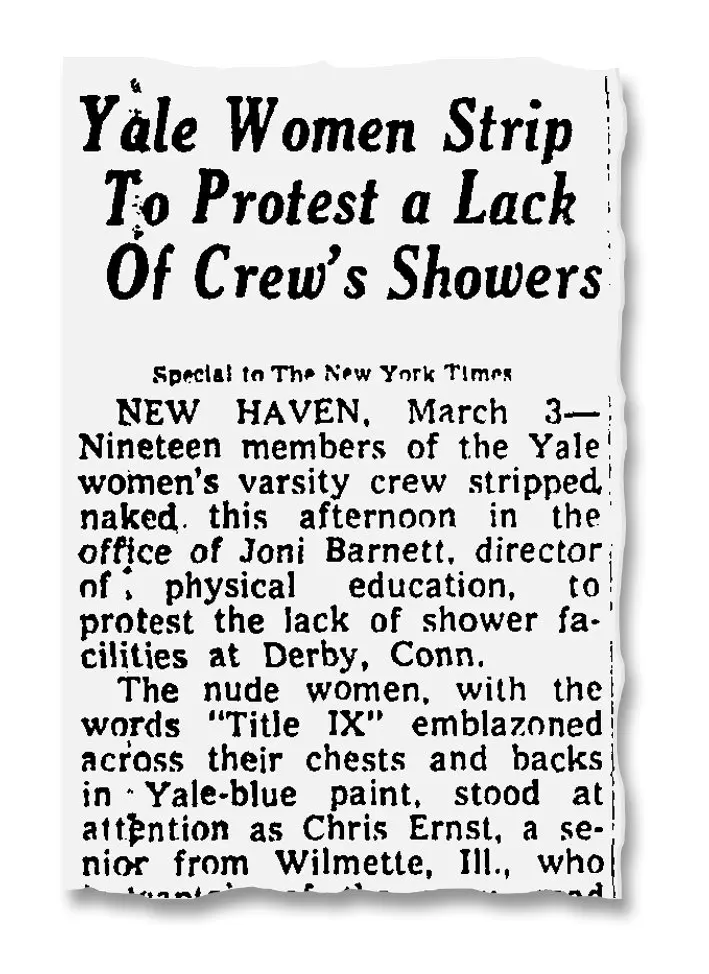Experts claimed for years that distance running was damaging to women’s
health and femininity.
In 1967, women weren’t allowed to officially enter the Boston
Marathon, so Kathrine Switzer entered that year as “K.V. Switzer” to
hide her gender.
Two miles in, an official tried to eject her from
the course, a moment captured in dramatic photographs. She finished
anyway, becoming the first woman to complete the race as an official
entrant.
“We learned that women are not deficient in endurance and
stamina, and that running requires no fancy facilities or equipment,”
Switzer wrote in The New York Times in 2007.
Women were officially
allowed to enter the race in 1972. Women’s marathoning joined the
Olympics in 1984.

Jock Semple, center right, tried to hustle Kathrine Switzer, No. 261, off the Boston Marathon course in 1967.Credit...Paul Connell/The Boston Globe, via Getty Images
The year 1973 was a big one for Billie Jean King, the trailblazing tennis star.
She founded the Women’s Tennis Association. She led a movementfor female players to earn equal prize money in tournaments that featured players of both sexes.
And, on a September night at the Astrodome in Houston, she epitomized her crusade for gender equality when she handily beat Bobby Riggs, a self-described male chauvinist pig, in the Battle of the Sexes.
King went on to receive the Presidential Medal of Freedom in 2009 for her work championing the rights of women and gay people. She is considered to be one of the most important athletes of the 20th century.
“Everyone thinks women should be thrilled when we get crumbs,” King once said. “I want women to have the cake, the icing and the cherry on top, too.”
Yale rowers strip to protest lack of women’s showers

Chris Ernst is a two-time Olympic rower. But in the spring of 1976, she was the captain of Yale University’s women’s crew team — and sick of not having proper showers to use after practice.
She led 18 teammates in an eye-catching protest at Yale’s athletic office. The athletes stripped to their waists, revealing the words “Title IX,” which had been drawn in blue marker on each woman’s back and breasts.
The Times ran an article in the next day’s paper, and a photograph of the history-making event also ran in The Yale Daily News.
Within two weeks, the female rowers had new locker rooms. And, across the country, educators began viewing Title IX — which had been in effect for just four years — as a law that required compliance.Venus Williams wins a victory for women off the court

In 2007, after pressure from the tennis great Venus Williams and others, Wimbledon announced that women’s tennis players would receive prize money equal to the men’s.
Williams had made a failed plea to Wimbledon’s governing body the night before she won the title in 2005. And in 2006, she wrote an op-ed essay in The Times of London titled “Wimbledon Has Sent Me a Message: I’m Only a Second Class Champion.”
“Have you ever been let down by someone that you had long admired, respected and looked up to?” she wrote. “Little in life is more disappointing, particularly when that person does something that goes against the very heart of what you believe is right and fair.” After the policies changed in 2007, she was awarded $1.4 million for her fourth Wimbledon victory, the same amount as the men’s champion, Roger Federer.
Statement by UN Women on discrimination against female athletes: “Running in the face of discrimination”

UN Women expresses its strong concern that the recent ruling by the Court of Arbitration for Sport on female athletes with naturally elevated levels of testosterone contravenes the international human rights norms and standards expressed in the United Nations Human Rights Council’s resolution of March 2019 on the ‘Elimination of Discrimination against Women and Girls in Sport’.
Indian sprinter Dutee Chand was the first to fight a case against the International Association of Athletics Federations’ (IAAF) hyperandrogenism rule and win. Now South African runner Caster Semenya has brought a case against the IAAF’s new limits on testosterone levels.
The requirement for such athletes to medically reduce hormone levels in order to compete as women plays into a discriminatory and stereotyped equivalence between testosterone, masculinity, strength and achievement that has been challenged by medical doctors, human rights, and intersex advocates, with the scientific basis questioned. The proposed method of reduction and verification requires athletes to take additional hormones with potential negative side effects. This process can result in further human rights violations, just as previous invasive testing to determine the sex of female athletes has done. This constitutes a dark chapter in the history of sport that should close for good.
UN Women underscores the Human Rights Council’s concerns about the exclusionary impact of discriminatory regulations, rules and practices on women and girl athletes on the basis of their physical and biological traits and the consequent reinforcement of harmful gender stereotypes, racism, sexism and stigma.
Sexism in Sport

Elite sport continues to set men and women apart. The men’s decathlon has been contested at every Olympics since 1912 but there is still no place at major championships for the women’s event. While men play five sets at Tennis Grand Slams, women can only compete over three sets.
We also see significant gender gaps when we look at the number of women participating in sport – 1.5 million fewer women than men participate in sport at least once a month. We also see clear gender gaps when we look at the number of women working in sport at every level. Women make up only 18% of qualified
We work to ensure equality of opportunity by focussing on getting more women and girls participating in sport, more women working in sport at every level and by driving commercial investment in and media coverage of women’s sport. We also work to ensure that women and girls who do engage with sport receive equal respect to their male counterparts.
Deepening
Users
Persona
Key Features
UX Story
